“Richard I. Fine Presents the argument against paying County or Court Supplemental or Local Judicial Benefit Payments to Judges, to the US Supreme Court.”
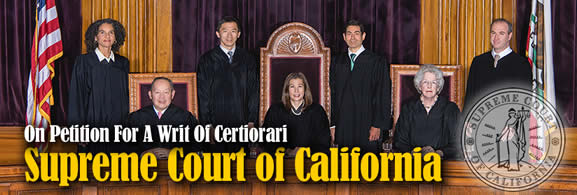 =========================================================================================
=========================================================================================
In The
Supreme Court of the United States
——————————— ♦ ———————————
CAROL PULLIAM,
Petitioner,
vs.
UNIVERSITY OF SOUTHERN CALIFORNIA,
Respondent.
——————————— ♦ ———————————
On Petition For A Writ Of Certiorari
To The Supreme Court Of The State Of California
——————————— ♦ ———————————
PETITION FOR WRIT OF CERTIORARI
——————————— ♦ ———————————
RICHARD ISAAC FINE, ESQ.
P.O. Box 789, 1187 Coast Village Rd., Ste. 1
Santa Barbara, CA 93102-0789
Telephone: (310) 622-6900
Email: richardfine@richardfinelaw.com
Counsel for Petitioner Carol Pulliam
==================================================================================================
COCKLE LEGAL BRIEFS (800) 225-6964
WWW.COCKLELEGALBRIEFS.COM
i
QUESTION PRESENTED
Do state court trial judges, court of appeal justices
and supreme court justices “war against the (United
States) Constitution” by denying state litigants Fourteenth
Amendment Constitutional due process when
each and/or all these judicial officers did not disclose
and recuse themselves as required by state law, state
Code of Judicial Ethics and/or other state or federal
requirements when he/she:
(1) currently receives or in the past received payments from:
(a) the county currently paying or paid the
Respondent for Respondent’s services; and/or
(b) an entity jointly offering services with Respondent;
(c) a partner, representative and/or affiliate
of the Respondent; and/or
(d) another county; and/or
(2) as a lawyer who personally represented
and/or his/her firm represented the county making the
payments to the judges in cases involving:
(a) the legality and/or the constitutionality of the payments; and
(b) subsequent statutes relating to the payments.
ii
LIST OF PARTIES
All parties appear in the caption of the case on the
cover page: (1) Carol Pulliam; and (2) University of Southern California.
MSS Nurses Registry was a defendant in the trial court.
CORPORATE DISCLOSURE STATEMENT
Nether Petitioner nor Respondent are stock corporations.
No public corporation owns 10% or more of the
shares of either Petitioner or Respondent.
RELATED CASES
No related cases exist.
iii
TABLE OF CONTENTS
Page
QUESTION PRESENTED…………………………….. i
LIST OF PARTIES ……………………………………. ii
CORPORATE DISCLOSURE STATEMENT ……….. ii
RELATED CASES …………………………………….. ii
TABLE OF AUTHORITIES ……………………………..vi
LIST OF ALL PROCEEDINGS AND DECISIONS
BELOW ……………………………………………………..1
JURISDICTION ……………………………………………. 2
CONSTITUTIONAL AND STATUTORY PROVISIONS
INVOLVED IN THE CASE ……………………………. 2
STATEMENT OF THE CASE…………………………. 3
A. Facts in Underlying Case ………………………….3
REASONS FOR GRANTING THE PETITION………..7
A. The California Supreme Court’s Denial of
the Petition for Review and the Court of
Appeal’s Denial of Petition for Rehearing
each “decided an important federal question
in a way that conflicts with relevant
decisions of this Court” …………………………………..7
B. The California Supreme Court has a Clear
and Present Pattern of Violating Cooper v.
Aaron ………………………………………………………..9
C. California has a Long History of Unlawful
“supplemental judicial benefit” Payments ………………10
WHEN AND WHERE FEDERAL QUESTIONS
SOUGHT TO BE REVIEWED WERE RAISED
AND HOW TREATED BY THE COURTS …………………..14
OTHER MATERIAL PETITIONER BELIEVES
IS ESSENTIAL TO UNDERSTAND THE PETITION
…………………………………………………………………………………..14
ARGUMENT AMPLIFYING THE REASONS
RELIED UPON FOR THE ALLOWANCE OF
THE WRIT …………………………………………………………………15
CONCLUSION ……………………………………………………………17
APPENDIX
Order, Supreme Court of California (Nov. 16, 2022) App. 1
Order, Court of Appeal of California (Sep. 8, 2022) App. 2
Opinion, Court of Appeal of California (Aug. 23, 2022) App. 3
Order, Superior Court of California (Dec. 11, 2020) App. 24
Judgment, Superior Court of California (Jan. 6, 2020) App. 26
Order, Superior Court of California (Jan. 23,
2019) App. 29
Petition for Rehearing, Court of Appeal of California
………………………………………………………………….App. 48
v
Page
Petition for Review, Supreme Court of California
…………………………………………………………. App. 68
Minute Order, Superior Court of California (Feb.
26, 2020) ………………………………………………… App. 86
Order, Superior Court of California (Feb. 26,
2020) ……………………………………………………… App. 88
vi
TABLE OF AUTHORITIES
Page
CASES
Cooper v. Aaron, 358 U.S. 1 (1958) ……………………… 7, 9
Hazel-Atlas Co. v. Hartford Co., 322 U.S. 238
(1944) ………………………………………………………………….. 15
Sturgeon v. County of Los Angeles, 167 Cal.App.4th
630 (2008) (Sturgeon I) ……………………… 6, 7, 10, 11, 12
Sturgeon v. County of Los Angeles, 191 Cal.App.4th
344 (2010) (Sturgeon II) …………………………………… 6, 12
Sturgeon v. County of Los Angeles, 242 Cal.App.4th
1437 (2015) (Sturgeon III) ……………………………. 6, 12, 13
United States v. Throckmorton, 98 U.S. 61
(1878) ……………………………………………………………..15
CONSTITUTIONAL PROVISIONS
U.S. Const. amend. XIV ………………………………………… 2
U.S. Const. art. VI ………………………………………………… 9
STATUTES
18 U.S.C. Section 1346 …………………………………… 2, 4, 7
28 U.S.C. Section 1257(a) ……………………………………… 2
LIST OF ALL PROCEEDINGS
AND DECISIONS BELOW
The decision of the highest state court to review
the merits was the California Supreme Court’s Denial
of the Petition for Review which appears at Appendix
1 to the Petition and is unpublished.
The decisions of the California Court of Appeal
denying the Petition for Rehearing and deciding the
appeal each appear at Appendix 2 and 3 respectively.
Each are each unpublished.
The relevant decisions of the State of California
Superior Court for the County of Los Angeles identifying
the Denial of the combined Motion for New Trial
and the Motion to Vacate the Judgment and the Judgment
each appear at Appendix 24 and 26, respectively.
Each are unpublished.
The removal from the State of California Superior
Court for the County of Los Angeles to the U.S. District
Court for the Central District of California.
The decision of the U.S. District Court for the
Central District of California.
The remand to the State of California Superior
Court for the County of Los Angeles from the U.S.
District Court for the Central District of California.
——————————— ♦ ———————————
JURISDICTION
The date on which the California Supreme Court
denied the Petition for Review was November 16, 2022.
A copy of the decision appears at Appendix 1.
The jurisdiction of this Court is invoked under 28
U.S.C. Section 1257(a).
——————————— ♦ ———————————
CONSTITUTIONAL AND STATUTORY
PROVISIONS INVOLVED IN THE CASE
United States Constitution and Statutes
United States Constitution, Fourteenth Amendment.
18 U.S.C. Section 1346.
Code of Conduct for United States Judges
Canons 1, 2A, 3C, 4A, D, E, G and H.
The Ethics Reform Act of 1989.
California Constitution and Statutes
California Constitution
Article 1, Section 7, Section 8, Section 24,
Section 26 and Section 28;
Article 2, Section 18;
Article 4, Section 17 and Section 18;
Article 6, Section 14, Section 16, Section 17,
Section 18, Section 19, Section 20, Section 21
and Section 22; and
Article 11, Section 10.
CCP Section 170.1(a)(6)(A)(iii).
California Code of Judicial Ethics
Canon 1, 2A, 3B, C, D, E and 4D.
——————————— ♦ ———————————
STATEMENT OF THE CASE
A. Facts in Underlying Case
Summary of relevant underlying state case facts
underscoring the Question Presented:
(1) Respondent (USC) owns, operates and staffs
hospitals;
(2) Petitioner (Carol) was a nurse employed in
one of USC’s owned and operated hospitals, USC Verdugo
Hills;
(3) USC admits and publicizes the County of Los
Angeles (LA County) currently pays USC $170 million
per year to “staff and operate” the Los Angeles
County/USC Hospital and has maintained the relationship
for over 100 years resulting in a LA County
interest in the outcome of the underlying state case as
a demonstration of USC’s operational and staffing abilities;
(4) Since the 1980s, LA County paid and currently
pays state Superior Court Judges sitting on the
California Superior Court for the County of Los Angeles
“supplemental judicial benefit” payments in addition
to their state compensation; and
(5) Such payments were held to be unconstitutional
by the California Court of Appeal, Review Denied
by the California Supreme Court, declared
criminal by California statute SBX 2 11, Section 5 and
violate 18 U.S.C. Section 1346.
The facts in the underlying case are most accurately
described in Petitioner’s Petition for Rehearing
of the California Court of Appeal’s Decision, Appendix
No. 48 and Petitioner’s Petition for Review, Appendix
No. 68.
The following is a succinct description of the relevant
facts in the underlying case disclosing:
(1) USC “admitted” its relationship with LA
County to be a joint venture of “Los Angeles County +
USC Medical Center” in the hospital business since
1885 (over 100 years) with USC also benefitting by LA
County paying “supplemental judicial benefits” to the
California Superior Court judges sitting on the Superior
Court for the County of Los Angeles ensuring USC
and LA County would win any cases against each of
them and/or jointly;
(2) the actions by USC to “cover up” its failure as
a hospital administrator through USC’s retaliation
against Carol for her refusal to cooperate in the
suppression of the cause of the death of a patient in a
USC hospital (USC Verdugo Hills) by:
(a) forging Carol’s signature on the “incident
report” blaming the other nurse for the incident (death
of the patient);
(b) inventing and spreading a story that
Carol “removed” drugs from the hospital’s drug vending
machine, which was proven to be false when it was
shown USC claimed the removal occurred on a day
Carol did not work at the hospital;
(c) spreading a story the DEA was investigating
Carol while knowing such story was untrue;
(d) sending out a “do not hire” notice relating
to Carol to nurse staffing agencies and others based
upon the above false stories; and
(e) presenting these false stories to both the
federal and California courts as part of the scheme to
prevail on summary judgment motions, a jury trial, an
appeal, a petition for rehearing and a petition for review
in addition to the “supplemental judicial benefits”
USC’s joint venture partner (LA County) currently
paid to Superior Court Judges Lu and Martin and previously
paid to Court of Appeal Justices Ashman-Gerst
and Chavez when each of them was sitting as a Superior
Court Judge for the County of Los Angeles as determined
from their “Judicial Biographies” the years
each were Superior Court judges and the years LA
County made the “supplemental judicial benefit” payments
to the Superior Court judges;
(3) the refusal of Judges Lu and Martin, Justices
Ashmann-Gerst and Chavez to disclose these LA
County payments in violation of Canon 3E (2) of the
California Code of Judicial Ethics and the refusal of
each to disqualify herself pursuant to Canon 3E (1) and
CCP Section 170.1(a)(6)(A)(iii);
(4) the refusal of Justice Liu to recuse himself
despite the fact he was the lead counsel for the
County of Los Angeles in Sturgeon v. County of Los
Angeles, 167 Cal.App.4th 630, 635 (2008) (Review Denied
12/23/2008) (Sturgeon I), Sturgeon v. County of
Los Angeles, 191 Cal.App.4th 344 (2010) (Sturgeon II)
and Sturgeon v. County of Los Angeles, 242 Cal.App.4th
1437 (2015) (Sturgeon III);
(5) the refusal of California Supreme Court Chief
Justice Tani Gorre Cantil-Sakaue, who denied the Petition
for Review, to disclose the “supplemental judicial
benefit” payments she received from Sacramento
County when she was a Superior Court Judge sitting
on the Superior Court for the County of Sacramento in
violation of Canon 3E (2) of the California Code of Judicial
Ethics and disqualify herself pursuant to Canon
3E(1) and CCP Section 170.1(a)(6)(A)(iii) as determined
from the years she was a Superior Court judge
from her “Judicial Biography” and the years Sacramento
County made the “supplemental judicial benefit”
payments to the Superior Court judges;
(6) The “supplemental judicial benefit” payments
were:
(a) held to be unconstitutional under
Article 6, Section 19 of the California
Constitution in the decision of Sturgeon I;
(b) denoted as criminal in SBX 2 11,
Section 5 giving retroactive immunity
from criminal prosecution, civil liability
and disciplinary action as of July 1, 2008
to the judges who received the “supplemental
judicial benefit” payments and the
governments and employees who paid
them; and
(c) violated 18 U.S.C. Section 1346 (the
intangible right to honest services.
——————————— ♦ ———————————
REASONS FOR GRANTING THE PETITION
A. The California Supreme Court’s Denial
of the Petition for Review and the
Court of Appeal’s Denial of Petition for
Rehearing each “decided an important
federal question in a way that conflicts
with relevant decisions of this Court.”
The California Supreme Court’s Denial of the Petition
for Review, App. 1 and the California Court of
Appeal’s Denial of the Petition for Rehearing, App. 2
each “decided an important federal question in a way
that conflicts with relevant decisions of this Court.”
The U.S. Supreme Court decision is Cooper v. Aaron,
358 U.S. 1 (1958) stating at page 18 in relevant part:
“Article VI of the Constitution makes the
Constitution the “supreme Law of the
Land.” In 1803, Chief Justice Marshall,
speaking for a unanimous Court, referring
to the Constitution as “the fundamental
and paramount law of the
nation,” declared in the notable case of
Marbury v. Madison, 1 Cranch 137, 177,
that “It is emphatically the province and
duty of the judicial department to say
what the law is.” This decision declared
the basic principle that the federal judiciary
is supreme in the exposition of the
law of the Constitution, and that principle
has ever since been respected by this
Court and the Country as a permanent
and indispensable feature of our constitutional
system. It follows that the interpretation
of the Fourteenth Amendment
enunciated by this Court in the Brown
case is the supreme law of the land, and
Art. VI of the Constitution makes it of
binding effect on the States “any Thing
in the Constitution or Laws of any State
to the Contrary notwithstanding.” Every
state legislator and executive and judicial
officer is solemnly committed by
oath taken pursuant to Art. VI, cl. 3, “to
support this Constitution.” Chief Justice
Taney, speaking for a unanimous Court
in 1859, said that this requirement reflected
the framers’ “anxiety to preserve
it [the Constitution] in full force, in all its
powers, and to guard against resistance
to or evasion of its authority, on the part
of a State. . . .” Ableman v. Booth, 21 How.
506, 524.
No state legislator or executive or judicial
officer can war against the Constitution
without violating his undertaking to
support it.” (Emphasis added.)
B. The California Supreme Court has a
Clear and Present Pattern of Violating
Cooper v. Aaron.
The California Supreme Court violated Cooper v.
Aaron, supra, on three occasions since 2021 establishing
a clear and present pattern to violate Article VI of
the Constitution and deny the California citizens’ and
residents’ due process.
The previous two denials were:
(1) The Third Appellate District appeal in RYAN
CLIFFORD v. ALPHA EPSILON PI FRATERNTY,
INC., Appeal No. CO87528, Petition for Review Denied
Supreme Court No. S274222 (06/15/2022); and
(2) The Sixth Appellate District appeal in
PETRA MARTINEZ, STANLEY ATKINSON v. U4RIC
INVESTMENTS, LLC, Appeal No.H049626, Petition
for Transfer of Writ of Error Coram Nobis Denied, Supreme
Court No. S273818 (6/01/2022).
This clear and present pattern suggests the Court
reaffirm Cooper v. Aaron, supra, either by:
(a) granting the Petition for Writ of Certiorari
by accepting the case for a full
hearing; or reversing the California
Supreme Court and Court of Appeal
Denials, Per Curiam and voiding all
decisions of the judicial officers who
refused to disclose and recuse themselves.
(b) Either alternative will send the underlying
case back to an unbiased
trial court, if one exists in California,
or sending the case to a U.S. District
Court judge who had not accepted
“supplemental judicial benefit” payments.
C. California has a Long History of Unlawful
“supplemental judicial benefit” Payments.
Sturgeon I showed the “supplemental judicial benefit”
payments began in the 1980s. The payments were
justified by the Los Angeles County Board of Supervisors
with argument the payments were necessary to
“attract and retain qualified people to serve as judges
on the LA Superior Court.”
No evidence was given to support the argument.
The LA County Supervisors did not disclose Article
II, Section 4 of the Los Angeles County Charter allowed
the LA County Supervisors to receive the same
compensation as “that now or hereafter prescribed
by law for a judge of the Superior Court in and
for the County of Los Angeles” (Emphasis added.)
By 2007, LA County had paid out approximately
$400 million to approximately 437 Superior Court
judges and simultaneously raised the compensation to
the LA County Supervisors.
Other counties followed LA County.
A report ordered in SBX 211, Section 6 entitled
“Report Prepared by the Administrative Office of the
Courts, Judicial Council of California: Historical Analysis
of Disparities in Judicial Benefits: Report to the
Senate Committee on Budget and Fiscal Review, the
Assembly Committee on Budget, and the Senate and
Assembly Committees on Judiciary (Dec. 15, 2009)”
(Report) at Appendix D Supplemental Judicial Benefits
in FY 2007-2008 and showed at page 1 approximately
90% of California’s approximate 1,600 Superior
Court judges received “supplemental judicial benefit”
payments.
The Report also showed at page 12, the judges
worked to overturn Sturgeon I, using public money of
the Superior Court of Los Angeles and the Administrative
Office of the Courts as follows:
“In response to the Sturgeon case, the California
Judges Association, the Superior Court of
Los Angeles County, several judicial leaders,
and the Administrative Office of the Courts
worked together to propose legislation that
would adequately prescribe supplemental
benefits.”
SBX 2 11 shows Darryl Steinberg, the then-President
Pro Tempore of the California State Senate “pushed
through” SBX 2 11 in three days.
In addition to Section 5, SBX 2 11 reinstated the
“supplemental judicial benefit” payments in Section 2,
which was codified as Govt. Code 68220 (a) allowing
the counties to keep paying the sitting judges the monies
they paid them on July 1, 2008 “on the same terms
and conditions as were in effect on that date.”
This provision was held to be constitutional as an
interim revenue measure in Sturgeon II in which the
Court also affirmed Sturgeon I.
The Sturgeon II Court concluded that since judicial
compensation is a state and not a county responsibility,
it expected the Legislature to adopt a uniform
statewide system of judicial compensation.
This did not occur. In Sturgeon III, the Court extended
the payments to all judges sitting in a court in
which judges received county payments on July 1,
2008, stating at 1450 in relevant part:
“The bottom line: Section 68220 subdivision
(a) plainly requires any county paying its
judges supplemental benefits as of July 1,
2008 to continue to pay its judges supplemental
benefits, including all judges who took
office after July 1, 2008 – albeit subject to the
right of the county in the first two sentences
of subdivision (b) to terminate those benefits
after specified notice. The county has no
choice and no discretion to “fix” judicial
compensation, which has thus been prescribed
by the Legislature. The opt-out provisions
of the first two sentences of subdivision
(b) provide the only choice a county has in that
situation, and even then there’s no fixing of
compensation, just a choice to pay the
prescribed amount or not to pay any supplemental
compensation at all. The last
sentence of subdivision (b) is unconstitutional
surplusage.” (Emphasis added.)
The Court in Sturgeon III again called for the Legislature
to solve the problem.
The Legislature has not acted to this day.
During this entire time, none of the California
judges or justices were, or are, disclosing the payments
in cases in which the county was a party, was a part of
a joint venture or had an interest in the outcome of the
case as shown in the underlying case.
The result was, and is, as shown in the underlying
case, California’s citizens’ and residents’ constitutional
rights were violated in every type of case from civil,
civil rights, criminal, dependency, eminent domain,
family law, injury, probate, property, etc.
In essence, the entire California judicial system
was and is corrupted by the judges and justices committing
“war against the (United States) Constitution.”
A further result of the judges’ and justices’ “war
against the (United States) Constitution” should be
rendering their decisions legally void due to Fraud
Upon the Court by a judicial officer, who concealed
his/her plan to refuse to obey the law and disclose
he/she was receiving illegal “supplemental judicial
benefit” payments.
——————————— ♦ ———————————
WHEN AND WHERE FEDERAL QUESTIONS
SOUGHT TO BE REVIEWED WERE RAISED
AND HOW TREATED BY THE COURTS
The Federal Questions sought to be reviewed were
raised in the Court of Appeal Petition for Rehearing,
Appendix 48, Denied by the Court of Appeal, Appendix
2; and the California Supreme Court Petition for Review,
Appendix 68, Denied by the California Supreme
Court, Appendix 1.
——————————— ♦ ———————————
OTHER MATERIAL PETITIONER
BELIEVES IS ESSENTIAL TO
UNDERSTAND THE PETITION
1. Report Prepared by the Administrative
Office of the Courts, Judicial Council of
California: Historical Analysis of Disparities
in Judicial Benefits: Report to the
Senate Committee on Budget and Fiscal
Review, the Assembly Committee on
Budget, and the Senate and Assembly
Committees on Judiciary (Dec. 15, 2009).
2. SBX 2 11.
——————————— ♦ ———————————
ARGUMENT AMPLIFYING THE
REASONS RELIED UPON FOR THE
ALLOWANCE OF THE WRIT
California’s population is 39 million people according
to Census Bureau estimates.
It will reach 41.372 by July 1, 2023, and accounts
for 12% of the population of the United States according
to 2023 Population USA.
The socio-economic effect of 12% of the population
of the United States being denied United States Constitutional
due process because California’s judicial officers
are at “war against the (United States)
Constitution” mandates the Court accept the Petition
for Writ of Certiorari or reverse the California Courts
Per Curiam with an order voiding their decisions in
which the judicial officers did not disclose their conflict
of interest and did not mandatorily recuse themselves.
The precedent of United States v. Throckmorton,
98 U.S. 61, 65-66 (1878) was cited to the California
Court of Appeal in the Petition for Rehearing, Appendix 63.
The Court is respectfully invited to review the
holding of Hazel-Atlas Co. v. Hartford Co., 322 U.S. 238,
247-248 (1944) stating equitable relief is available to
overturn judgments obtained by fraud in relevant part:
“We have, then, a case in which undisputed
evidence filed with the Circuit Court of Appeals
in a bill of review proceeding reveals
such fraud on that Court as demands, under
settled equitable principles, the interposition
of equity to devitalize the 1932 judgment despite
the expiration of the term at which that
judgment was finally entered. Did the Circuit
Court have the power to set aside its own 1932
judgment and to direct the District Court likewise
to vacate the 1932 decree which it entered
pursuant to the mandate based upon
the Circuit Court’s judgment? Counsel for
Hartford contend not. They concede that the
District Court has the power upon proper
proof of fraud to set aside its 1932 decree in a
bill of review proceeding, but nevertheless
deny that the Circuit Court possesses a similar
power for the reason that the term during
which its 1932 judgment was entered had expired.
The question, then, is not whether relief
can be granted, but which court can grant it.
Equitable relief against fraudulent judgments
is not of statutory creation. It is a judicially
devised remedy fashioned to relieve
hardships which, from time to time, arise from
a hard and fast adherence to another courtmade
rule, the general rule that judgments
should not be disturbed after the term of their
entry has expired. Created to avert the
evils of archaic rigidity, this equitable
procedure has always been characterized
by flexibility which enables it to
meet new situations which demand equitable
intervention, and to accord all the
relief necessary to correct the particular
injustices involved in these situations.”
(Emphasis added.)
The California judicial officer’s fraud is clear and
manifestly demonstrated in this Petition for Writ of
Certiorari.
——————————— ♦ ———————————
CONCLUSION
Petitioner respectfully submits for the above reasons
Certiorari be granted or a Per Curiam decision be
issued: (1) reversing the California Supreme Court and
Court of Appeal Denials, and (2) voiding all decisions
of the judicial officers who received county “supplemental
judicial benefit” payments and refused to disclose
such payments and recuse themselves.
Dated: February 14, 2023
Respectfully submitted,
RICHARD ISAAC FINE, ESQ.
P.O. Box 789, 1187 Coast Village Rd., Ste. 1
Santa Barbara, CA 93102-0789
Telephone: (310) 622-6900
Email: richardfine@richardfinelaw.com
Counsel for Petitioner Carol Pulliam
Download the PDF Document HERE




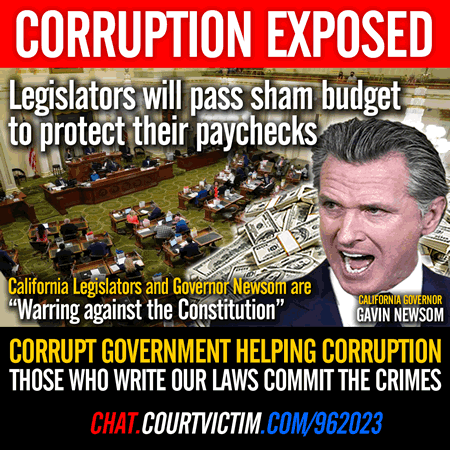
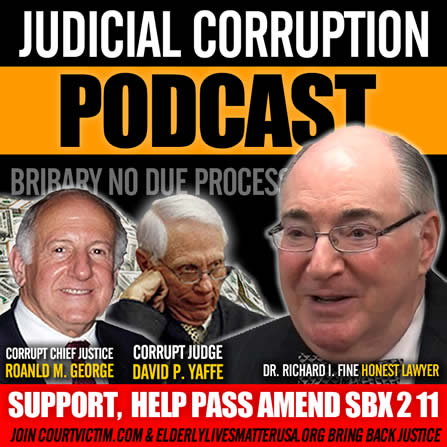

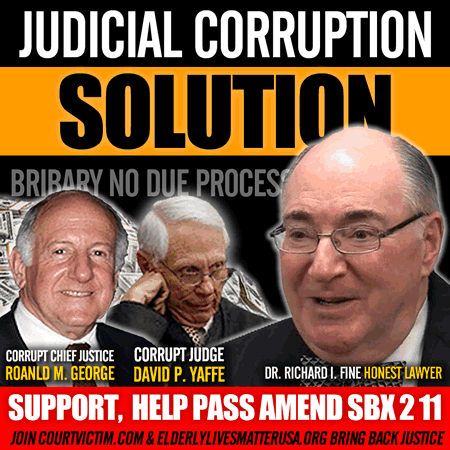


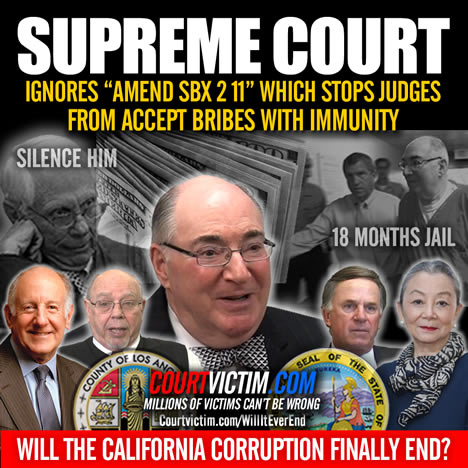
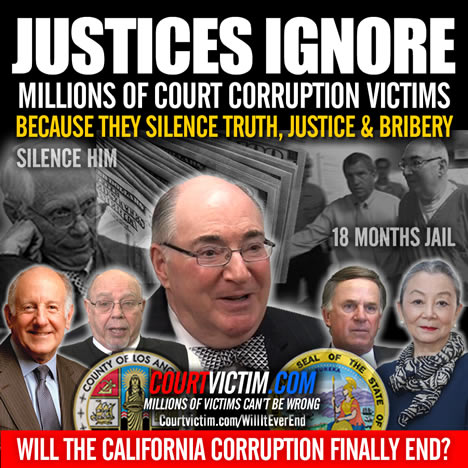
 =========================================================================================
=========================================================================================